Don't wanna be here? Send us removal request.
Text
Polly,
I do think also that using tumblr was a great experience for me because it is something I have never used before. I also liked how the class was more so on our own and we learned the material and reflected on it. This helped us incorporate our own thoughts and let us read others thoughts on the content. I enjoyed reading your blog posts and you are on of my classmates who definatley has a passion for art!
Week 16 - Final Post
Blog - Week 16
Can one really be in love with rules? I am seriously going to copy/cut/paste the “10 Rules for Students and Teachers” by Sister Corita Kent and hang it in my “work” space in my house. Every single rule was like hitting the nail on the head. I have to say that Rule Six (6) is my favorite, “Nothing is a mistake. There’s no win and no fail, there’s only make”. I wish I would have known about these rules when my children were still at home, as this would have perfect for them to read every day before heading off to school, sporting events, and their jobs. Think I will send them a copy as well.

Marina Abramovicc’s “An artist’s life Manifesto” was interesting to read. We can all apply these lessons to our own lives, as we are all artists in one way or another. There is a lot of truth within this manifesto, from keeping the friends that make you happy around to not telling lies to planning your own funeral. I know this is off the topic, but as a single parent, I have planned my funeral down to the last detail so that my children would not have to deal with anything but my death.
My overall experience in the class has been a real eye opener for me. Having to post to blog each week was a great learning tool for me, as I enjoyed reading all the posts. Having the opportunity to pick a relevant artist each week, instead of just assigning one, really helped to expand my knowledge of other artists out there that I probably would have never discovered. Learning about all the mediums under each category was sometimes a bit overwhelming, but I am glad to have the chance to learn more, and you were there to guide us and give encouragement (otherwise known as feedback) along with way.
I once thought that art was all about paintings, sculptures, drawings and theater – now I have to add in performance art, photography, digital art, film making, sound art and visual art. I have also learned that I need to keep an open mind when looking at all the various “pieces” of art that I come across. We all need to keep our eyes open, ears ready to listen, and our minds ready to accept whatever message the artist is trying to convey.
I can’t wait to take all this new knowledge of art with me when I take my next trip back to New York City and hit up a few museums or galleries to see what has transpired since my last visit. I have added a few names to my list of authors I would like to see more of like, Jeff Koons, Liza Lou, Swoon, Tara Donovan, and Spencer Finch will most diffidently come to mind when I visit the 9/11 Memorial Museum once again.

Thanks to all my classmates for a fun semester of learning. I enjoyed reading all your posts and re-posts of our assignments!
5 notes
·
View notes
Text
Week 16
This week’s readings were about Sister Corita Kent and Marina Abramovic. I thought that Sister Corita Kent’s Ten Rules for Students and Teachers was interesting. I was just a kind of confused if these rules are supposed to apply to doing artwork or just for the classroom. I really liked this list of rules. Two of my favorite ones were rule two: general duties of a student: Pull everything out of your teacher; pull everything out of your fellow students and rule nine: be happy whenever you can manage it. Enjoy yourself. It’s lighter than you think. I think that both of these rules are very true and inspiring. I also liked reading about Marina Abramovic’s, “An artist’s life Manifesto.” I didn’t think there should be a list about what an artist should and should not do. I can see how some of these things would make an artist a better artist.
I think that this course was a positive experience for me. I came into this course not knowing a single thing about art. Then I started this class, I was a little nervous about it because I thought there is no way I am going to be able to find interest in this course whatsoever. I started the readings and I did not mind reading about the art, but some of the readings got to be a little too long. I found myself being engaged with the pictures of the artwork in the book and it made me think. I think that by looking at the pictures made me want to read about them. I do think that this course changed how I looked at art. When seeing the artwork I kept thinking to myself what made this artist create this work and why? Art is not just something you look at. There is meaning behind that piece of artwork. It can be a very powerful meaning to the artist. Some of the pieces of artwork I struggled with finding a meaning behind them. I liked in the videos we watched when the artist would state why they created their artwork. It makes the piece a lot more unique. Some of the categories we learned about I did not have interest in at all. I think that when you are not interested in something it is hard to find meaning behind that piece of artwork.
Prior to this class the only aspect of art I knew was the artwork I did in elementary school, middle school, and high school. When in art classes in high school we were told to create what the teacher wanted us to create. I don’t think that is necessarily considered your own unique piece of art. I did not know that there was this much artwork beyond what I learned in my past. I do not think art will be a huge part of my future. I think that if I come across art I will examine it, but I do not see myself going to an art museum in my free time. One thing I can see myself doing is hanging a piece of artwork on my walls in my house because there are beautiful and inspiring paintings that would be awesome as decorations. I can also see myself exploring artwork in big cities such as buildings. Those interest me. Below I posted two pictures of buildings I would love to see in person!

Blue Water Shopping Complex Eric Kuhne

Performing Arts Centre for Abu Dhabi created by Zaha Hadid
0 notes
Text
I also struggled with navigating photoshop programs. It seems like it would be easy but it is not at all! My sisters and I would always fight who would get the computer so we could use the paint tool. I honestly do not even think that this tool is on computers anymore. It is crazy how much digital art has advanced. The restroom clip was a little weird, but I honestly thought it was super interesting to watch.
Week 15
Your reflections on the reading
Digital art is a very difficult type of art to master. I have dabbled with digital art in school, mainly with photoshop and it was difficult to navigate if the user does not know how to use the program. I remember when I was a kid I would go on the painting app on the computer and doodle. It is amazing how much digital art has advanced since the mediocre painting apps. It is incredible how many colors are available to choose from. Honestly, where can I get ahold of all these colors. There are so many types of digital art, such as virtual reality and 3D. I am not a very artistic person, I love photography but with the subjects that I prefer it is more of a snap a picture and hope for the best situation.
Your reflections on the videos/media
It is always fun looking at how people live in different parts of the world. I love looking at different cultures and furthering my understanding of the world so it was really interesting hearing her reasoning behind her art. That being said, I do not think I would have understood the art very well if she had not been talking throughout the video. I love how her art is so large and all-encompassing. The work overruns the room and brings all the attention to it. I am honestly not sure if the walls are curved or if Tabaimo is really just that phenomenal with digital art. It was interesting looking at the restroom clip and looking at the differences between the public restrooms that we know and the ones portrayed in the video. While that did fascinate me, the subject of the clip and the abortion showcased sickened me. I am all for pro-choice, and it is interesting to see how problems that plague us also plague people across the world.

Connections/comparisons you find between the two
There is the obvious connection of digital art. The curve of the walls gave a somewhat 3D feel with Tabaimo’s work. Tabaimo’s work was quite different from Dinosaurs from the reading because she does not incorporate actual footage into her artwork. Her art seems to go beyond what is typically done with digital art, she uses all the tools and resources available to her to create her artwork. It seems that people typically do not consider digital art to be art but it is obvious that Tabaimo works extremely hard on her artwork and that digital is a type of art.
Connections to another artist’s work from the “Relevant Artists” section of the course content
I chose Tacita Dean as my relevant artist for this week. Dean was born in the United Kingdom in 1965. She has published a few books throughout the years. Dean’s work is all her own. She primarily focuses on film but does dabble with other mediums. Her film work really manages to capture what can evade photography and other mediums. Dean really focuses on the meaning behind the film and how it affects the individuals seeing it.

2 notes
·
View notes
Text
Week 15
This week’s content was about Digital Art. This type of art is something that is much more common in today’s world. From reading this week’s chapter I learned how far computers have come to create such realistic and clear art on the computer. In the book they shared a picture from the movie Dinosaur. Our brains are just seeing continuous drawings which look like action to us. It would take a long time to create a film like this. There would be a lot of drawings to be done. I would have to agree with what the book said about how digital art can be easily altered. This is definitely a con with digital art. Somebody could easily download the piece of art and change it and say it is their work. One piece I really liked that was in the book was called Wondrous Spring by Charles Csuri. I love the bright colors in it. It almost looks like it could be a handmade painting. This image could easily be altered by switching up the colors in it.
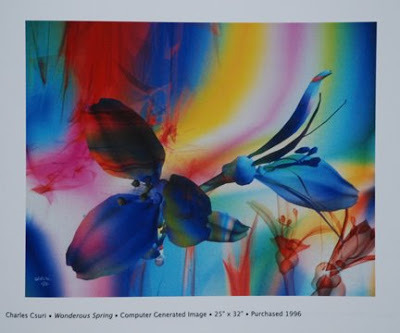
Wondrous Spring by Charles Csuri
This week’s video was about Tabaimo. At first I thought her work was a little different, but then as I kept watching it got more interesting. I kept thinking what is going to happen next? I always think if you are watching something that makes you wonder what is going to happen next it must be a good piece of work. Some things about her artwork were weird, but I think “weird” in artwork is sometimes a good thing because it makes you think. I think Tabaimo wants you to really think when viewing her work. She said that she takes fifty percent credit for her work and the other fifty percent belongs to the viewer. I think that the meaning behind her work is to make you think of life beyond here one earth and to make you think about other’s lives. For example, when she said the water in the toilet being flushed has to go somewhere. She makes you think about things you would not think about on a daily basis. I also really enjoyed the way her work was setup when looking at the piece of work that dealt with the bathroom. It really made you feel like you were there with those people. I noticed the viewer moved out of the animations way when she went to go by the sink. I think that this work compares to when the book talked about the movie Dinosaur because Tabaimo had to do the same think with her animations where she would draw and then put it into a slideshow to made it into action.
I chose to research about Cory Arcangel. He was born on May 25, 1978. He is post conceptual artist who makes work in many different types of media. This includes drawing, music, video, performance art, and video game modifications. He is best known for his video modifications. He is best known known for his Photoshop Gradient Demonstrations produced using Photoshop’s gradient tool. Super Mario Clouds is a piece that he did where he left the blue sky and clouds by themselves and took the video game part out of it. I think that Cory has a passion for video games and enjoys working with animations. I think the meaning behind is artwork is to show how art is incorporated into video games and that they are not just “games.” They do have artwork incorporated into them.
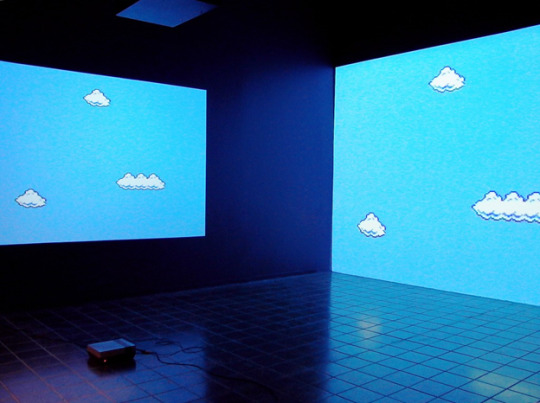
Super Mario Clouds 2002 by Cory Arcangel
0 notes
Text
Polly,
I never thought about closing my eyes while listening to Überorgan. I can see how the sound would remind you of somewhere haunted. The sound coming from this piece was definatley not a pleasing sound. I also did not really enjoy looking at the tip of the finger piece. It gives me the chills, but the detail on the top of the finger is very clear and looks real. Tim Hawkins artwork is for sure unusual and unique.
Week 14 - Sound Art
From what I gathered on the internet Sound art really become more known around 1983, which would have been my junior year of high school and this really is the first time I am hearing about this medium. In a nutshell, to me sound art is like a combination of music with art to some degree. As I am typing this part of my blog post I can hear my wind chimes in the distance so I am wondering if wind chimes would be consider art or music/sound? I am also wondering about the tour of the 9/11 Museum in New York City, as you have the option of taking the tour with audio (which I highly recommend) or without. So when I took the tour with audio, is that consider Sound Art as it gave the tour an “auditory experience with a visual component”.
After reading “An Introduction to Sound Art”, by Robert Worby, I was on an informational melt down. There was so much to learn about Sound Art, from the very beginning with the Futurists, to American composer John Cage, to today’s term of soundscape. I have discovered that fall into the, “People tend not to listen very much, they hear sound but they rarely listen”, category. I decided that I needed to do more listening, so I grabbed that old fashioned tape recorder and went outside for an hour to just sit and listen for my own research. Some of the sounds that I heard were, my wind chimes, a lawn mower, birds, vehicles driving by, children’s laughter, a door closing, dogs barking and low chatter from my neighbors.
Tim Hawkins is certainly an artist who thinks outside the box. I would love to crawl into his mind to see what he is thinking! His piece Überorgan, is one massive piece! The sound(s) that he has created were giving me the chills. I, for one, could close my eyes and picture myself in a haunted place with those sounds coming out of the walls. Perhaps it didn’t help that I was watching scary movies before doing this portion of our homework. The “tip of the finger” piece really didn’t do anything for me as it was kinda creepy looking. Not quite sure what he is trying to convey to me with that particular piece.

For this week’s relevant artists I picked Scottish artist Susan Philipsz. According to www.tate.org.uk, “Philipsz uses her own voice to create uniquely evocative sound installations that play upon and extend the poetics of specific, often out-of-the-way spaces”. Susan Philipsz has never had vocal training, nor can she read or write music. She takes songs that have all ready been recorded from various traditional folk music and sixteenth century ballads to songs by Nirvana and David Bowie, .and sings them in her own way. One of her best installations of sound art is a 16th-century Scottish ballad called “Lowlands” that she sang in three parts, and each one of those parts were installed under three bridges in Glasgow.
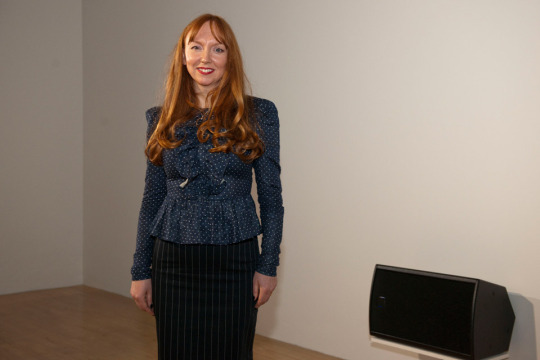
4 notes
·
View notes
Text
Week 14
This week’s content was about Sound. My first reaction to reading the topic for this week was a little bit confused. How could sound be art? After reading Robert Worby’s article I got a better understanding of this.
I like how he stated that sounds are definitely not things and that when sound is gone there is nothing left but a memory. He said sound moves through the air and leaves nothing behind. This is very true. Once you listen to it you won’t ever be able to listen to that same exact sound again. I agree with him when he says we focus more on what produced the sound rather than the sound itself. When I think of sound art I think of music. I consider music to be art because someone had to compose the music. It was interesting to read about how John Cage had such an impact on sound art. I thought it was interesting that at his first performance the pianist shut the lid on the piano and there was no sound coming from the piano but you heard the crowd. He incorporated the listeners into his work.
This week’s video was about Tim Hawkinson. I think his work is interesting, but seems complicated to me. I like how he uses everyday materials to make his artwork. His piece that dealt with the sound of rain drops reminded me of an IV. He made the drops have a rhythm and there was a valve that helped with this. This reminded me of the way an IV works because of how you can set it to the amount of drops to come out. I thought the sound of the rain drops was relaxing. The sculpture he made to incorporate audio that was the size of a football field was awesome. It was called Uberorgan. The fact that he had sound incorporated through all of that was mind blowing. I thought that the sound was something that I personally wouldn’t want to listen to, but it was still interesting. The sound just didn’t seem soothing to me. I think that the meaning and why Tim does this work is because of his passion for music. He has had a passion for music his whole life. I thought that Tim’s work was different than the reading because Tim decided to incorporate sculpture and sound together.
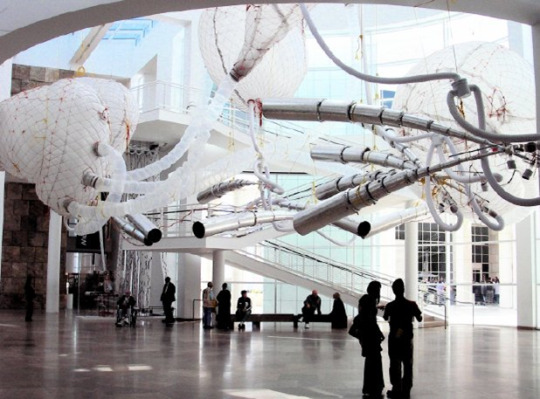
Tim Hawkinson Uberorgan
The relevant artist I chose to research about was Haroon Mirza. He was born in 1977 in London. He is best known for his sculptural installations that generate audio. He has his MA from Chelsea College of Art and Design and an MA in Design, Critical Practice from the University of London. He won international acclaim for installations that test the interplay and friction between sound, light waves, and electric current. He creates kinetic sculptures, performances, and immersive installations. The National Apavillion of Then and Now is one of his creations. It is an anechoic chamber with a circle of light that grows brighter in response to increasing drone and goes completely dark when there is silence. He combines furniture, electronics, and found or original video footage into his work. He explores the shifts and overlap among states of noise, sound, and music. In his installation Regaining a Degree of Control a turn table spins a radio that picks up interference from a light bulb, while a strobe oscillates to a rhythmic music loop. I think that Haroon is an artist that takes time with his work and likes to explore the different sounds before he commits to them. I also think that Haroon has a passion for music and this is his calling to create sound.
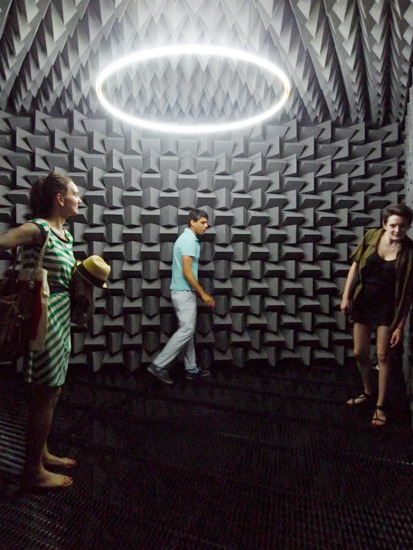
1 note
·
View note
Text
I would have to say I also confused on this week’s content. It was even harder to learn about because this is a type of art that I am not really interested in. Vanessa Beencroft sounds like a great artist. I almost think I might be interested in her work. It was just hard for me to find interest in this type of art, but her work sounds quite interesting. I also did like how they incorporate many people into their work.
week 13
This week was about social practice. I was some what interested learning about this chapter but I did get confused on some of the information. I think it is interesting have many people be included creating this artwork. This week’s video was about Tania Bruguera who is a politically motivated performance artist who explores the relationship between art, activism, and social change in works the examine the social effects of political and economic power. I thought it was pretty interesting. I am not as interested in her artwork like I have been with the other artist however everyone’s pieces of art are unique in his or her own way of creating it.
Vanessa Beencroft was born April 25, 1969 in Genoa Italy. Vanessa first studied at the Civico Liceo Artistico Nicolo Barabino on April 25th, 1969 in Genoa, Italy. Vanessa Beecroft is known for her performance, photography, drawing, painting, and sculpture. Vanessa Beecroft’s work is largely performance based often featuring female models as living art objects that exist somewhere between figure and object, static and dynamic. A lot of her work is informed by her personal struggle with an eating disorder and she explores issues of body image and femininity in contemporary culture. Vanessa Beencroft has worked with designers and celebrities.
4 notes
·
View notes
Text
Week 13
This week’s content was about social practice. I was not looking forward to reading about this week’s content, but after I read the articles I was a little confused and more interested to move onto the video for this week. I do like the idea of having individuals participate and engage in creating artwork. In the first article I read by Jeriah Hildwine I agreed with him by saying that Casey McGonagle’s comment, “Do regular stuff, only it’s art,” best explains explaining social practice from what I read so far about this topic . I thought it was good that he was doing his research on this topic before he decided to dive in and teach about it. I would definitely need to take his class in order get to know this topic a little more. I really liked the piece Untitled by Gonzalez-Torres. I really liked the meaning behind it how taking a piece of candy each time represented his HIV inflicted partner life come to a slow end. I like how it said in the article that “the viewers complete the work.” They do complete the work and that is what makes the piece so unique.
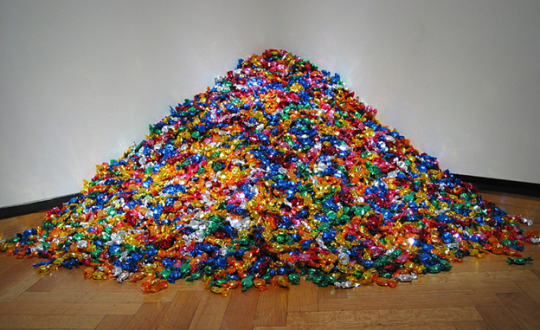
Untitled by Gonzalez-Torres
This week’s video was about Tania Bruguera. I thought the video was interesting, but I do not think her type of art is a type that I am interested in. I liked the art done by Gonzalez- Torres because it seemed simple, but really interesting. It reminds me more of performance art. I do not think her art work or ideas are bad they are just not my type. I think it is awesome that she has so much social interaction involved within her work. People are involved and engaged. I think her opening the Arte Util museum was a good idea. It is not a museum you walk into and look and leave. You walk in and are socially participating in making the artwork. I think the meaning behind her artwork is to be yourself and to be free. I think that this video does connect with the readings because it does show the idea behind social practice art and gives you a better idea behind it.
I decided to research about Harrell Fletcher for this week’s relevant artist. He was born in 1967 in California. He now lives in Portland, Oregon. He was a key figure in the development of social practice art and relational art in the United States. He received his BFA from the San Francisco Art Institute in 1990 and his MFA from the California College of Arts in 1994. He became known for making projects in collaboration with strangers and non-artists. He then went on to found the Social Practice Program in the art department at Portland State University where he still currently is a faculty member. He worked with artist, Miranda July, and they founded the online arts project called Learning to Love You More. This website offered assignments to artist’s whose submission became part of an ever-changing series of exhibitions, screenings, and radio broadcasts presented all over the world. Below is a picture of Harrell Fletcher doing his social practice art. In the Come Together project he did in New York at Apexart, he asked people to choose other people who then choose topics on which to give ten-minute public lectures.
Overall I struggled with this week’s blog post. Towards the end I did not find myself interested at all in this type of art. I think that social work deals with helping people out rather than social practice is just coming together to create a live piece of artwork and to socially interact within art.
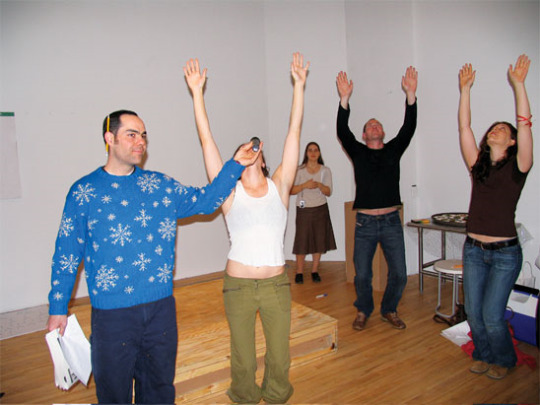
Harrell Fletcher Come Together
0 notes
Text
Polly,
Wow that is awesome that you have been the assistant drama director for 15 years! This topic was easy for you I am sure! I can connect with you also with Janine Antoni’s statement. I am only 19 soon to be 20 and I know my life shouldn’t be balanced at this early in life but it seems like it will never be! I am really trying to get to the point in my life though.
Week 12 - Performance Art
Finally, a topic that I have some knowledge and experience in, as I am the Assistant Drama Director for the Oelwein Community School District. I have had the position for over fifteen years now and absolutely love it! Although making these productions is what I love, there is nothing – and I mean nothing – better than going to New York City to see a show on Broadway, heck even off-Broadway! I have had the opportunity to see Cats, Wicked, Kinky Boots, The Phantom of the Opera and Hedwig and the Angry Inch, plus many more!

With that being said Performance Arts covers so many other aspects that just a musical or drama performance. As our first reading “Performance Art, The Art Story” stated, “Performance is a genre in which art is presented "live,” usually by the artist but sometimes with collaborators or performers”. You can also include mimes doing an act, going to see a rock concert, a person sitting on the corner playing an instrument or singing, Readers Theater, seeing a show choir perform, why really, the list is endless of performance art possibilities! I did find the sections of Body Art, Ritual and the Auto Destructive Art interesting and new to learn about.
The article on Janine Antoni regarding “Touch” and “Moor” kept my attention while reading it. Not sure I would be one to want to walk a tightrope, but there is always a first for everything. I personally love where Ms. Antoni stated, “Balance is an interesting thing because I think it’s a state we’re always striving for, but it’s an impossible state”. Holy cow she hit the nail on the head with that statement. I will be 51 on April 6 (yep right around the corner) and to this day, I still don’t think and feel that I have my life in any sort of balance. Not, that I don’t try, but I guess that is all a part of life.
Janine Antoni in “Loss & Desire” was a little strange to watch. I am in love with her “lifeline” rope and think I may do something similar with my family and friends. What a great way to incorporate memories to share with others. Strange, for me at least, was the tub of lard, the cow frame and the licking of the chocolate bust of her. Not sure why I find those pieces strange, I just do. I found that the piece 2038 (bath with cow) brought back some memories for me, as my grandparents were dairy farmers and spent many a day with those cows. Though I have to say I never thought about taking a bath with one.
I know some of you will most likely disagree, but for me Bree Newsome’s act of removing the Confederate Flag from South Carolina’s State House was just a stunt. I do not consider it a work of performance art. Yes, she did bring back the attention and talk regarding the removal of the Confederate flag, but she did that in a way she could have been harmed. What if she fell while trying to cut that flag down? Who would have been blamed - Bree Newsome? The government? the Confederacy? I agree that the flag needs to come down, but perhaps she could have found a better way to accomplish her goals.
My relevant artist this week is American visual artist Carolee Schneeman. According to
www.theartstory.org
she, “has used her body to examine the role of female sensuality in connection to the possibilities of political and personal liberation from predominantly oppressive social and aesthetic conventions”. After scrolling through what seems like a million pictures, Ms. Schneeman, does indeed use her body to create crazy pieces of artwork. Not sure what I would say to the opening of a Christmas card to her and significant other in the nude. I was kind of lost for words for a bit. Her work is a bit bizarre for me and I really couldn’t see myself ever going to one of her exhibits.

1 note
·
View note
Text
Week 12
This week I read about performance art. I do not know much about performance art, but I learned a little more about it after reading the content for this week. From reading the first article, I was shocked on how much history has impacted performance art. One thing I was not shocked about was how paintings and sculptures kind of went away for a little bit to introduce performance art. I figured this was why performance art came about. I think that people got bored with just looking at art and actually wanted to see art live. My favorite part of the reading for this week was learning about Janine Antoni’s work in performance art. I was so interested to see what this was all about. I had to go watch the video when I was reading. The video almost looks unreal because her walking on the horizon is so accurate. It is truly amazing. The meaning behind this piece made me like the art even more. I am confused as to why Bree Newsome removing the confederate flag is considered to be art at all. In my opinion, it is more of a social act. I don’t really consider this action to be art.
The video for this week was about Janine Antoni. I was already interested in this artist when reading her interview. I think the rope she made to use in her art was something that meant a lot to her. She knows exactly where every piece came from within her rope. This truly represents her whole life so far. I also liked her piece 2038. It was quite interesting. You never really think about it, but we do drink from the cow so her piece makes sense to me, why not let the cow drink from her? I love animals and this is why I liked this piece. I thought it was a little weird how she made herself out of soap and out of chocolate and then used it/ate it. I think the meaning behind her artwork is to appreciate life and the obstacles that come with it. I also think that she really likes to incorporate herself into her work. This way her artwork connects to her life more.
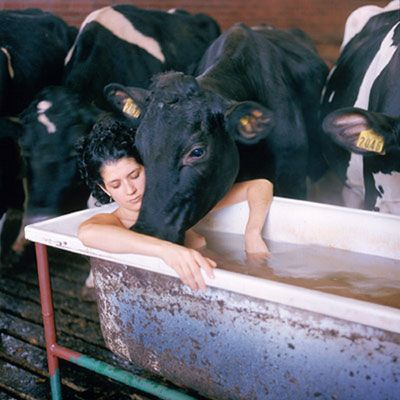
Janine Antoni 2038.
I decided to research about Carolee Schneeman for this week’s post. She was born October 12, 1939 in Pennsylvania. She is an American visual artist known for her discourses on the body, sexuality, and gender. She received her B.A. from Bard College and a masters of fine arts from the University of Illinois. When she was younger her friends said she was a mad pantheist because of her relationship and respect of nature. Her earliest connections with art and sexuality started when she was between four and five. Her family was supportive of her naturalness and freeness of her body. Her father was a physician who had to deal with the body in different states of health. This is why he supported her. When she was in college at Bard she began to realize the difference between male and female perceptions of each other’s bodies while serving as a nude model for her boyfriend’s portraits and while painting nude self-portraits. She started out painting and then became interested to show her passion through performance art. I think the meaning behind her art is to be comfortable with your body. I think her artwork is a little excessive. I think she could prove her point in a different way. Below is a picture of Carolee Schneeman’s performance artwork.
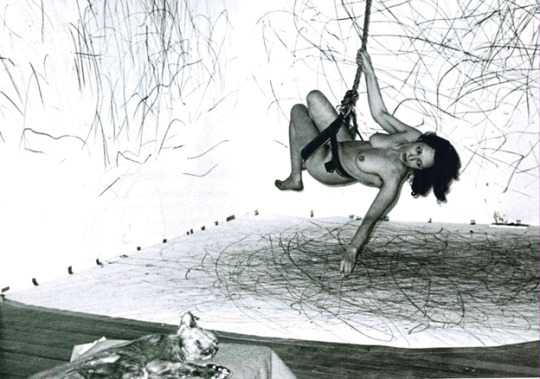
1 note
·
View note
Text
Zaha Hadid has great artwork! I also loved the Performing Arts Centre for Abu Dhab. It looks so pretty especially with the water surrounding it.
I thought Maya Lin’s idea to add the lights to look like stars in the ice rink was a brilliant idea. Not only is the ice rink something for people to do, but it is also artwork to look at!
We also have an abandoned ice rink that is outside and it would be awesome for an artist to transform it to something like this. It would be awesome to go to when it gets dark out.
Week 11
Your reflections on the reading
Honestly, I wasn’t too excited to read this chapter about architecture. It’s just a part of art that I am not drawn too and that I don’t think about very often. However, once I started reading through the chapter and seeing all the featured works I actually really enjoyed it and I’m not really sure why I thought I wouldn’t enjoy it. I like this description from the book, “The architect is an artist, but also a social servant.” I think that explains architecture very well, because they are artists but they also have to cater to the wants and needs of their clients, complete extensive training, and remember regulations among other responsibilities. I loved many of the featured works in the chapter, but I think the Performing Arts Centre for Abu Dhabi created by Zaha Hadid is my favorite. I was a little stunned by it even, because it is so different from what we usually see and it is just so aesthetically pleasing. I love the leaf like glass areas, the entrance, and blue is my favorite color so that’s a plus.

o Your reflections on the videos/media
I thought the video on Maya Lin was interesting. It was interesting to see how vastly different her styles are but also how they sometimes combine. She creates sculptures and does architecture and while she doesn’t actively mix the two in her works sometimes it just works out that way. I particularly enjoyed seeing the ice skating rink she created in a park that was just sort of dead and that no one really used or enjoyed. I also really liked h ow she incorporated the lights in it to make stars. I have never been ice skating because there are not a lot of options around where I live. There is one building in a park in our town that used to be an ice skating rink but I don’t think it’s been used in years. I don’t remember it ever being open or used for anything actually, which is a shame because if that’s the case then it’s just taking up space. I think it would be amazing if someone were to come by and create something like Maya Lin did.

Connections/comparisons
Well there is the obvious connection between the reading and the Maya Lin’s work, which is the fact that Maya Lin is an architect and has architecture projects that she works on. With the ice skating rink, she was taking the people that would be using it and the general public into consideration, which relates to the idea that an architect is an artist as well as a “social servant.” She has to take multiple factors, like its use, the public and regulations, into consideration.
Connections to another artist’s work
For this week I chose to research Zaha Hadid, the same woman I mentioned earlier who made the Performing Arts Centre. I really love her work! I think she has more of what I would call a futuristic style and I just love all of it because they’re so different from what we usually see while still being incredibly beautiful.

1 note
·
View note
Text
Week 11
This week’s content was about architecture. I enjoyed looking at all of the different buildings artists created. I did notice that in the content they talked more about how the buildings are built rather than the art side of things and why the artists created these buildings. Although they did not talk about the art side of things within these building it was interesting to read about how and why buildings are built the way they are. For example, how they would create buildings with different roofs for certain climates. Some of the buildings I thought were unique was the cathedral in Moscow with the onion domes, the Singapore skyline at sunset, the design for performing arts Centre, and the blue water shopping complex. All of these are buildings that I have never seen before because they are all in large cities. I would enjoy going to a big city to look at all the unique buildings there are. They are beautiful in pictures and I am sure they are even more beautiful in person!

Blue Water Shopping Complex Eric Kuhne
This week we watched a video about Maya Lin. I really liked her project with the skating rink. At first when she was using that atlas I thought she was going to create a huge globe where the ice rink was. One thing that I liked about it was that it is a piece of artwork that you can use and not just look at. I thought they were going to get rid of the ice skating rink at first. I think that some of her works are not only pieces of architecture but she also creates many sculptures. Maya wants us to see the beauty in her art, but especially the beauty of the land or city surrounding it. I think that this relates to the book more towards the end of the video. This is when she talked about the buildings she created.
I chose to research about Andrea Zittel this week. She was born in California in 1965. She received a BFA in painting and sculpture in 1988 from San Diego University and an MFA in sculpture in 1990 from Rhode Island School of Design. Her sculptures and installations transform everything necessary for life like eating, bathing, and socializing. Her projects extend into her own home and wardrobe. She will wear a single outfit for an entire season and constantly remodels her home to suit changing demands and interests. She tries to attain a sense of freedom through her structures. She is more interested in revealing human needs for order. She said, “People say my work is all about control, but it’s not, really,” she remarks. “I am always looking for the gray area between freedom—which can sometimes feel too open-ended and vast—and security—which may easily turn into confinement.” I like the way Andrea thinks about her artwork. From looking at her pieces I think that the meaning behind her artwork is comfort. She seems to create pieces that would make a home feel more comfortable. Along with this the pieces are cool and unique. I think that comfort relates to freedom from how she explained that she is looking for the gray area between freedom. The image below is a piece of work done by Andrea that shows how she creates things that are necessary for life. I think that Andrea’s work compares to Ludwig Mies van der Rohe’s work. They both created art work that could be used in our everyday lives. For example, Ludwig Mies van der Rohe created many different types of chairs.
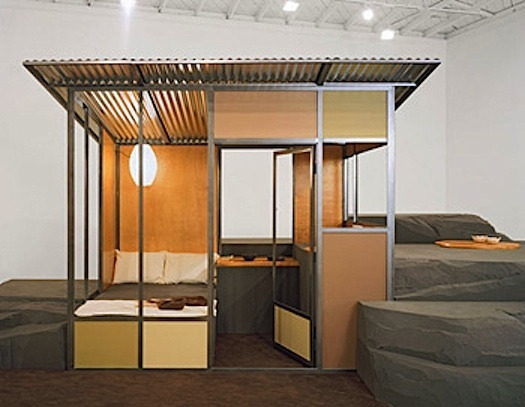
Andrea Zittel Critical Space
0 notes
Text
Chris,
I also thought the video for this week’s content was a little confusing, but Kimsooja still seems like a great artist that is very passionate about her work. I think that working with metal would be difficult. You would really have to know a lot about the malleability and ductility of the metal. I enjoyed looking at the piece you chose to put in your post that was done by Maija Grotell. I did clay pots in high school and they never turned out that good!
Week 10
Week 10
This week’s reading was over Craft Media. Craft Media deals with clay, metal, wood, glass and fibers. I can say I did enjoy the reading this week because I am used to working with my hands while crafting things and this chapter covers the many ways you can do this with craft media. I think the reading covered each media very well and again gave great examples of each. The one style I was not real interested in was the fiber section. While I do believe it is an art form and some pieces are interesting, I just have no real connection with fibers. I did enjoy reading about clay and the different clay bodies that work better for different methods. The second most interesting style was Metal. To me metal working is interesting because of the malleability and the ductility of the metal. It makes the artist have to be more adaptive working with metal then others because of the changes in material during heating and cooling of the metal. When reading about wood, it talked about the art work from Maharaja Anup Singh called Hindola. This piece is very detailed and while I’m sure took a long time to complete. I feel a little over whelmed looking at it because it has so much going on. I feel that it takes away from the ritual swing and the meaning behind the swing. The picture below I chose to show is work from Maija Grotell an artist that was talked about in this weeks reading.

The video this week with Kimsooja through me off a little. At first I had a hard time following what she was talking about and where I thought she was headed in her story. When talking about her body compared to a needle and thread in time, I don’t follow how this may be connected with this week’’s reading other than the waving of fibers.

This week for my relative artist I picked Justin Novak. I chose Justin because of his sculpture skills and felt I can relate to his work more the others that specialized in fiber works. A little history about Justin is that he has a master’s in Art and teaches at the University of Oregon. He has won several awards and grant over the years I have messed around with clay and the different styles including slab building, hand building and wheel throwing. It was interesting reading about clay forms because it took me back to high school and the throwing wheel. I never really mastered the wheel but I did successfully make a few bowls and had fun doing it.
1 note
·
View note
Text
Week 10
This week I read about Craft Media. I enjoyed reading about this material because not only is it art, but it is art that we can use every day. I was most familiar with clay. I have done slab building, coil building, and hand building by pinching. I did several pots in my high school art class that I still make use of today. I made my coil pot about 4 or 5 years ago and my mom still uses it to put one of her plants in. One thing I was not familiar with was wheel throwing. This method looks interesting and almost looks easier to do than the rest of the methods. I learned in high school that it does take a lot of time to complete a piece of art work made of clay. I think it is neat that Paula Winokur visits certain landscapes around the world and incorporates them into her art work. I enjoyed looking at her piece White Butte. Another piece I liked from this week’s content was by Dale Chihuly called No. 2 Sea Form Series. It is a piece made of glass. I like the colors that are reflecting off this piece of artwork. Clay, metal, wood, glass, and fibers helped people in history make materials for their everyday use. This helped make people’s lives easier.
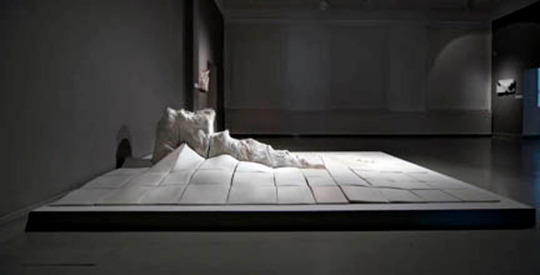
Paula Winokur “White Butte”
I thought that Wondering about the Future of the Smithsonian's Craft Museum article was confusing. I think that you would have to visit this museum in order for this article to make sense. What I got out of the article was that Craft Museums are disappearing. This is probably because this is not really modern day art and is slowly disappearing.
Kimsooja’s artwork seems very powerful to me. Her speech at the end where she says, “My intention is to reach to the totality of our life in art,” inspires me. She seems like an artist who takes a lot of pride in her artwork. Kimsooja stated in the video that the meaning behind her artwork has to deal with her Korean life and the bottaris, which are the bundles, represent her family history. Her family was always on the road. I really enjoyed her artwork at the end called To Breath a Mirror Woman. I think the meaning behind this piece is related to the title. It shows the power of a woman. I think that this work more relates to installation other than craft media. It seems like most of her pieces were meant for a specific site.
This week I chose to research about Marie Watt. She is an American Artist. She was born in 1967 in Seattle, Washington. She has her AFA from the Institute of American Indian Arts. She has a BS from Willamette University and also has an MFA in painting and printmaking from Yale University. She works primarily in lithography, sculpture, and installation. Her work draws from history, biography, protofeminism, and indigenous principles, and addresses the interaction of the arc of history with the intimacy of memory. She uses materials such as wool blankets, cedar, and iron. From reading about Marie Watt I think that the meaning behind her work is to help others feel comfort when losing a loved one. She does this by creating blankets. She said that we are received in this world by blankets and wrapped in them when we leave. They provide comfort to small children and comfort to when we are sick. One of her pieces called “Forget Me Not,” is a piece she created to remember soldiers killed in the Iraq and Afghanistan wars. She made this by creating a series of memorial portraits handstitched using wool blankets. Her work could definitely help people during the grieving process when a loved one dies.
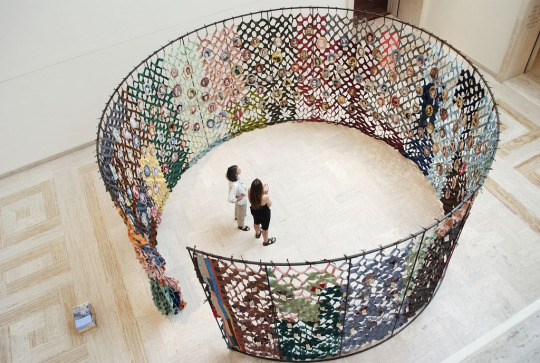
“Forget Me Not” by Marie Watt
1 note
·
View note
Text
Chris,
I never thought of it that way but I think Do Ho Suh was going through that point in his life where he needed to leave home and move on with his future plans. He is a brilliant artist for incorporating his feelings into his art. This would definitely help him find comfort when being away from Korea for such a long time. I think that most of his artwork has to deal with his Korean life. It is interesting to see his culture through his artwork.
Week 9
This week we covered Installation art and many examples of installation art. Installation of art can either be temporary or permanent. These pieces can be placed in spaces such as museums and galleries indoors and also in outdoors spaces in public or private spaces. I think this opens the doors for many different piece to find a place to display. The best thing with art is that you may not even know you’re walking through a piece at all. Examples of this is from the 5 Wonders in New York. Imran Qureshi at the Metropolitan shows us how a garden can become an installation of art showing passion with the colorful floor and some take it as blood and crime. I for one do not see where they get blood but instead think it accents the garden and shows the colorful side of the flowering season.

The video segment Do Ho Suh talks about an issue I think most of us go through at some point in our life. The fact that at some point we need to leave home and move on with our future. This causing a lot of our comfort zones to be left behind. In this video he not only makes art but also solves part of a problem he was dealing with in life. He discovered a way to replicate his home as it was growing up. I really like the park monument he did with the people holding up the monument. I think it shows how it takes everyone to hold the weight and that one person can’t do it by themselves. I also enjoyed hearing about the school system and how everyone was to go into the military after school. I think this has a lot to do with the way he thinks and seeing thing in being an artist. I believe the installation art he made with all the dog tags is a great idea and symbolizes not only art but the way of life for all Koreans.

This week I chose Spencer Finch for my artist. Even though he is best known for his light installations, I feel his other work is also very interesting and entertaining. A little background on Spencer, he was born in Connecticut in 1962 and now lives and works in Brooklyn New York. Above is the installation I chose of Spencer’s. I picked this because of the colorfulness and also shows a before and after timeframe.
3 notes
·
View notes
Text
Week 9
This week I read about installation art. When I started reading this week’s content I was quite confused. At first I thought installation art was just sculpture. Once I kept reading it started to make more sense. An installation piece must be site specific and have been designed to fit a certain space. Installation pieces seem to have a variety of categories. Installation art would definitely be tricky and take a lot of thought for the artist. The virtual reality aspect of installation art caught my eye right away and then I went on to view more pieces of this type of installation on google. This would be awesome to view in person. I especially liked the rain room on the second part of the reading. I think it would be interesting to hear from the artist on how exactly they created this. I think that the rain room would help with stress and to calm people down.
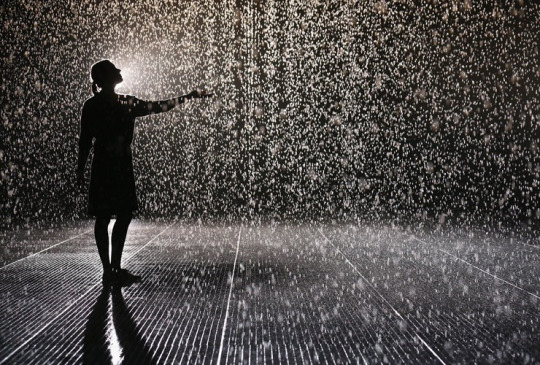
The Rain Room
This week’s video was about Do Ho Suh. I like the way he incorporates his Korea life into his art work. He seems to be very passionate about where he is from. From watching the video I feel as if he is sad and homesick. The meaning behind him making his fabric sculpture of his home is safeness. He travels a lot and he seems to get homesick and this art is a perfect way to keep him from missing home. I think the rest of his pieces such as the people holding up the sculpture, the outfits they wore for school, and the sculpture that related to his military life all share a similar meaning. Do Ho Suh likes to express his cultural life in his artwork. Although I do not think he enjoyed all of the things about living in Korea, he still expresses this in his artwork. I think this video compares to the readings in the fact that they are installations but Do Ho Suh does not seem to talk much about the perception of space within his artwork.
The relevant artist I chose to research about was Karla Black. She was born in 1972 in Scotland. She received her B.F.A. in sculpture in 1999 from the Glasgow School of Art. She then received her M.F.A in 2004. She creates abstract sculptures using everyday materials. Some of these materials include powder, soaps, gels, and pastes, plaster, chalk, paint, and paper. She carefully arranges them on the floor or suspended from the ceiling. These sculptures are usually made on site and include specific evidence of the process of her creation. You can see this through fingerprints and dust. I like Karla’s work because it includes many pastel colors which I love. I think that the meaning behind her artwork is to just light up the room and to make someone’s day brighter. All of her pieces seem to be in rooms with a ton of light and windows. I think that Karla’s work compares mostly to Spencer Finch’s work. I think that he has the same outlook on his artwork. He uses a lot of bright colors to brighten up the windows and light in a room.

Karla Black “Pleaser”
1 note
·
View note
Text
Polly,
I felt the same way about ephemeral materials being used for a sculpture. It would be hard to draw the line of when to get rid of the piece. I do not think just because it is art that it should be preserved. The nature of the piece of art is so that it can be seen for a few days and then thrown away. I like how the the relevant artist you chose, Tara, uses pieces like paper cups and pencils to create artwork. This way you do not have to worry about the materials decaying. She has a lot of great pieces of artwork.
Week 8 - Sculpture
I never knew there were four plus ways of creating sculptures. I do have some knowledge of the medium of carving, as I have an uncle who is an avid carver. Each year he makes each one of his nieces and nephews a small piece of art. This past year I received this wooden “egg” – as I am not sure what to really call it.
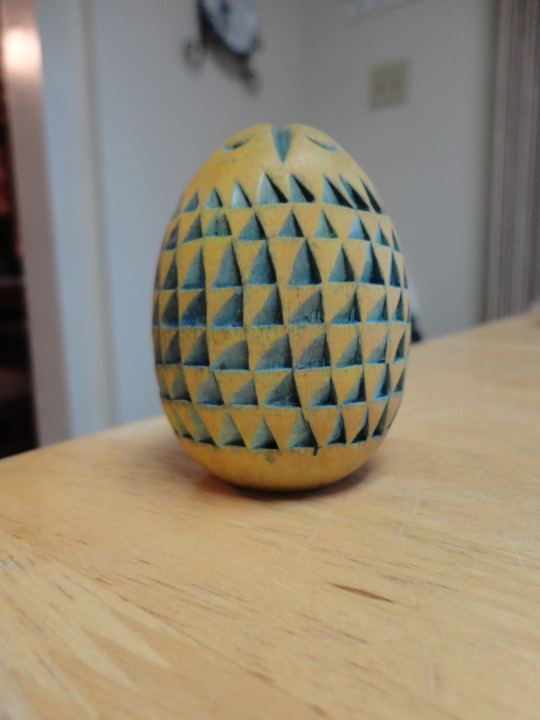
Recently a high school friend visited Florence and took a picture of “David” for me, as that is my favorite piece of sculpture – hands down! He stated that is was absolutely beautiful to see in person and should be one everyone’s must see list.
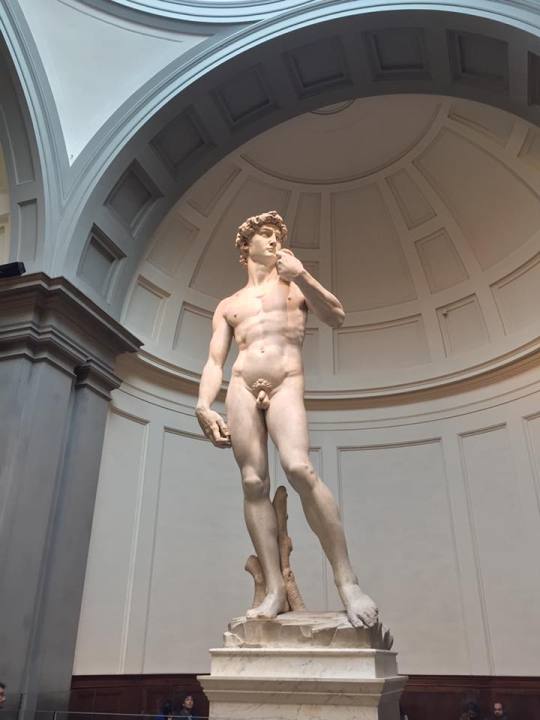
Regarding the horse assembly pieces made by Deborah Butterfield – I can’t believe that she creates these horses from discards and they sell for $240,000.00! Holy buckets, maybe I should start looking at all objects in a different light!
The article on preserving ephemeral materials was quite interesting and does pose a problem for both artists and museums alike. Zoe Leonard’s “Strange Fruit (for David)”, leaves a bad taste in my mouth. I’m not sure I would even want to see decaying pieces of fruit scattered around the floor, as the first thing that came to my mind were bugs, and the smell of the decaying fruit. I understand the importance of preserving pieces of art so that they may be seen for generations, but where in the heck do you draw the line? Museum curators should talk in depth with artist and do extensive research on all material(s) used before making that call; glad I don’t have to do that.
Kara Walker’s, “A Subtlety, or the Marvelous Sugar Baby,” was a huge project in every sense of the word. When I first read the description of the video I thought she and her team were making this sculpture from sugar, not huge blocks of polystyrene foam covered in sugar. I have to say this is the first time I have ever looked upon sphinx that is a black woman, very interesting to say the least. I get the feeling that as a black artist Kara was defining what happened during slavery and working in the sugar cane fields by placing this piece within the confines of the Domino Sugar Factory located in Brooklyn, NY. I also want to tie in that slavery was demolished (so-to-speak) just like the factory was at the end of her showing.
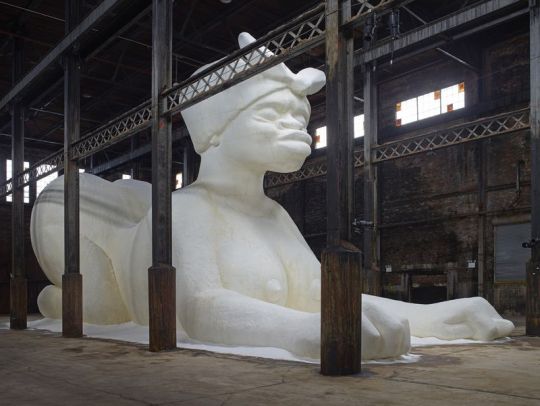
My relevant artist for this week is Tara Donovan, who is a contemporary American artist focused in sculptural and organic subject matter. Ms. Donovan likes to create large-scale installations and sculptures from items that we use every day. Items like tape, toothpick, paper cups, index cards, pencils, pins, paper, and my favorite buttons! Literally, thousands, upon thousands of buttons all glued together to make one simply amazing piece of sculpture entitled “Bluffs”. I thought it looked like a pretty piece of coral until I really started digging into the research. Tom Strini a writer at http://urbanmilwaukee.com is quoted as saying,
“Any one of them appears to be colorless and clear. But strange things happen as light travels through masses of them: It turns a dusky pink/mauve that I can’t recall seeing anywhere else. The varying densities within the piece make for an infinite scale of saturation of this beguiling color, which changes subtly with point of view.
And after scrolling thought photographs on her website, that is a correct statement. All the buttons are white/clear and depending on the amount of light is what color shows up. I really liked all of her pieces, but the “Bluffs” is what caught most of my attention.

4 notes
·
View notes